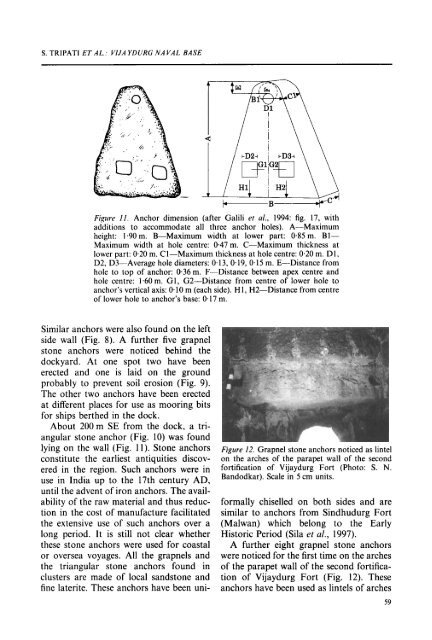Marine archaeological exploration and excavation of Vijaydurg—a ...
Marine archaeological exploration and excavation of Vijaydurg—a ...
Marine archaeological exploration and excavation of Vijaydurg—a ...
You also want an ePaper? Increase the reach of your titles
YUMPU automatically turns print PDFs into web optimized ePapers that Google loves.
S. TRIPATI ET AL.: VIJA YDURG NA VAL BASE<br />
Figure II. Anchor dimension (after Galili et ul., 1994: fig. 17, with<br />
additions to accommodate all three anchor holes). A-Maximum<br />
height: 1.90m. B-Maximum width at lower part: 0.85 m. BI-<br />
Maximum width at hole centre: 0.47 m. C-Maximum thickness at<br />
lower part: 0.20 m. CI-Maximum thickness at hole centre: 0.20 m. DI,<br />
D2, D3-Average hole diameters: 0.13, 0.19, 0.1 5 m. E-Distance from<br />
hole to top <strong>of</strong> anchor: 0.36m. F-Distance between apex centre <strong>and</strong><br />
hole centre: 1.60 m. GI, G2-Distance from centre <strong>of</strong> lower hole to<br />
anchor’s vertical axis: 0.10 m (each side). H1, H2-Distance from centre<br />
<strong>of</strong> lower hole to anchor’s base: 0.17 m.<br />
Similar anchors were also found on the left<br />
side wall (Fig. 8). A further five grapnel<br />
stone anchors were noticed behind the<br />
dockyard. At one spot two have been<br />
erected <strong>and</strong> one is laid on the ground<br />
probably to prevent soil erosion (Fig. 9).<br />
The other two anchors have been erected<br />
at different places for use as mooring bits<br />
for ships berthed in the dock.<br />
About 200m SE from the dock, a tri-<br />
angular stone anchor (Fig. 10) was found<br />
lying on the wall (Fig. 11). Stone anchors<br />
constitute the earliest antiquities discov-<br />
ered in the region. Such anchors were in<br />
use in India up to the 17th century AD,<br />
until the advent <strong>of</strong> iron anchors. The avail-<br />
ability <strong>of</strong> the raw material <strong>and</strong> thus reduc-<br />
tion in the cost <strong>of</strong> manufacture facilitated<br />
the extensive use <strong>of</strong> such anchors over a<br />
long period. It is still not clear whether<br />
these stone anchors were used for coastal<br />
or oversea voyages. All the grapnels <strong>and</strong><br />
the triangular stone anchors found in<br />
clusters are made <strong>of</strong> local s<strong>and</strong>stone <strong>and</strong><br />
fine laterite. These anchors have been uni-<br />
Figure 12. Grapnel stone anchors noticed as lintel<br />
on the arches <strong>of</strong> the parapet wall <strong>of</strong> the second<br />
fortification <strong>of</strong> Vijaydurg Fort (Photo: S. N.<br />
B<strong>and</strong>odkar). Scale in 5 cm units.<br />
formally chiselled on both sides <strong>and</strong> are<br />
similar to anchors from Sindhudurg Fort<br />
(Malwan) which belong to the Early<br />
Historic Period (Sila et al., 1997).<br />
A further eight grapnel stone anchors<br />
were noticed for the first time on the arches<br />
<strong>of</strong> the parapet wall <strong>of</strong> the second fortifica-<br />
tion <strong>of</strong> Vijaydurg Fort (Fig. 12). These<br />
anchors have been used as lintels <strong>of</strong> arches<br />
59
















